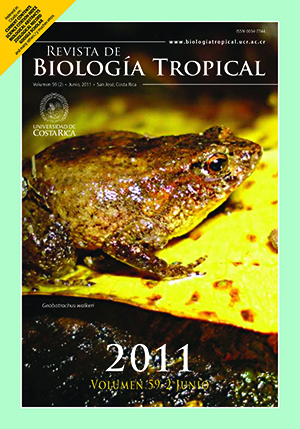Resumen
Geobatrachus walkeri belongs to a monotypic frog genus endemic to the San Lorenzo area, Sierra Nevada de Santa Marta, Colombia. This species has been categorized as endangered because of its small distribution area and the decline in the extent and quality of its habitat. It inhabits two forest types with different composition and structure, the native secondary forest and a pine plantation (dominated by Pinus patula). To compare the relative abundance and microhabitat use of this species in these habitat types, 30 quadrants/environment were distributed randomly. The individual number, microhabitat use and other aspects of its natural history were registered using visual encounter surveys in both sites, including non-sampled areas in the quadrants. The relative abundance of frogs was significantly different between habitats and among seasons. The highest abundance of G. walkeri relative to the total area was found in the pine plantation, being 2.3 times higher than in the natural forest. More frogs were significantly found during the rainy season; nevertheless, active individuals were also found during the dry season. Significant differences were found in the microhabitat use with respect to the forest type and season. The most frequently microhabitat used in the two forest types was the pine leaf-litter; besides, in the native forest, the microhabitat occupied more frequently presented medium and large size stones. Geobatrachus walkeri is a successful species in pine plantations, associated permanently to its leaf-litter environment where it seems to develop its entire life cycle. The clear modifications in the soils and water, derived from the introduction of the pine plantation in this area, seem not to have negatively affected the conservation and successful maintenance of this species.##plugins.facebook.comentarios##

Esta obra está bajo una licencia internacional Creative Commons Atribución 4.0.
Derechos de autor 2011 Revista de Biología Tropical
Descargas
Los datos de descargas todavía no están disponibles.






